Last night at Franklin High School, Portlanders got their first chance to kick the tires and test ride the Portland Bureau of Transportation’s update to the Bicycle Master Plan.
This plan, last updated in 1996, is important to Portland’s bike future for many reasons: it will set and inform policies related to how the City plans its transportation network, it will create points of leverage for advocates and citizens to hold the City accountable for their progress (or lack of it), it will identify and classify recommended bikeways, and it will encapsulate the City’s latest thinking on a variety of issues relating to bicycling (from enforcement to the economy).
Southeast residents got a chance to ask city bike planners questions, fill out comment cards, and soak up information from about 20 large posterboards that put the language of the plan into nice charts, photos and factoids.
The first board starting things off on a hopeful tone. It shared this vision for Portland in 2030:
“In 2030 Portland is a clean, thriving city where bicycling is a main pillar of the transportation system and more than a quarter of all trips are made by bicycles.”
I think we’ll achieve the first part of that way before 2030. The 25% mode share might take a bit longer. But overall, I like how PBOT is framing their efforts in terms of healthy, vibrant neighborhoods that are full of “Bicycles Everywhere!”.
Some of the boards had designated volunteers standing by to walk folks through the information or ask for specific feedback. Bike Gallery owner Jay Graves was asking folks what type of rider they were and then had them place a dot next to where they live. Traffic Division Lieutenant Bryan Parman was there to answer questions about enforcement policies.
PBOT bike parking manager Sarah Figliozzi had folks fill out bike parking comment cards — both where they’d like to see new parking installed, and what they think of existing facilities. Figliozzi told me they’ve got a lot of new on-street bike corrals planned for summer and she said the following locations will get corrals even sooner:
- St. Johns (finally!) near St. Johns Cinema and Anna Bananas Cafe at N Alta and Lombard.
- Alberta Street at NE 31st.
- Northwest Portland near Dragonfly Cafe at NW 24th and Thurman.
- In front of Widmer Brewing on N. Russell at N. Interstate.
My favorite part of the night was mining the boards closely for interesting bits and clues to things I hadn’t yet come across.
For instance, here are some drawings of large pavement markings that we’ll see on the upcoming bike boulevards (notice the size, up to 12-feet, much larger than the tiny little “dots” we have now):
And then there was this little gem of a sketch by PBOT bike planner Denver Igarta (“BMP” stands for Bike Master Plan):
I also noticed a detailed definition of a term that will make its debut in this update: “Bicycle Districts”. These would be areas (like the Pearl District) where “the intent is to make bicycling the vehicular mode of choice.”
Another board featured this funding statistic you can share around the water cooler with non-believers:
“For $60,000,000 you could build the country’s best bicycle network….OR….you could build approximately one mile of urban freeway.”
One of the most important bits of policy language in the entire plan will be policy 6.23. This is sort of the over-arching mission statement for bicycle transportation in Portland.
Here’s the existing version:
“Make the bicycle an integral part of daily life in Portland, especially for trips of less than five miles, by implementing a bikeway network, providing end of trip facilities, improving bicycle/transit integration, encouraging bicycle use and making bicycling safer.”
And here’s the new, more concise, proposed language:
“Create conditions to make bicycling more attractive than driving for trips of three miles or less.”
Overall, I think last night’s open house was a success. A diverse mix of residents showed up and many of them were engaged and filled out comment cards and/or talked with volunteers and city staffers.
One of them was Kenny Heggem. Kenny lives near Reed College and he was “really excited” for the open house. He filled out detailed comments about his desire for better bikeways on SE Woodstock, Harold, Reed, and Steele. He told me he never realized the amount of detailed thought that goes into creating our bikeway network and he loved that he, just an ordinary Joe Citizen, could come in and have a say: “It’s great that our city tries to include everyone in their decisions like this.”
Even with all the optimism a plan like this engenders, it’s still just a plan. The new policies, while exciting on paper, will have limited strength in forcing the hands of politicians and bureaucrats to do great things. Like I assume some of you are, I too am growing impatient of all the planning and talking and I want to see more action.
For over two years now, I’ve been hearing about how this or that policy “will be in the master plan update”. Finally we’re on the home stretch with this thing, and I’m excited.
Think of this plan as a playbook. When carfree superstar Gil Penalosa was in Portland over the summer, he mocked Portland for only being in the minor leagues. “Does Portland want to stay as champion of the little league of soccer across North America? Or, does Portland want to be champion of the World Cup?” he asked.
Now it’s all about the World Cup (or the Super Bowl if that’s easier to relate to), and to win it, we need a great game plan. The Bike Master Plan is that game plan, and once it’s done, all that will be left is to run onto the field and execute.
After this series of open houses, PBOT will release a draft plan for public comment in July. A Planning Commission hearing is tentatively set for for August 25th and it will likely be in front of City Council on October 21st. If all goes according to plan, all the new policy recommendations will be folded into the update of the all-important Transportation System Plan.
These open houses continue through May 18th, including another one tonight for East Portland (at David Douglas High). Check the full schedule and show up when it comes to your neighborhood.


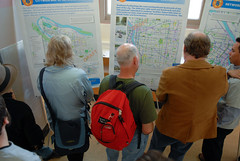
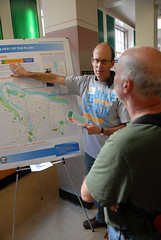
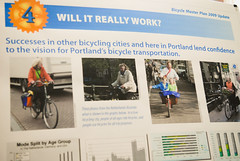
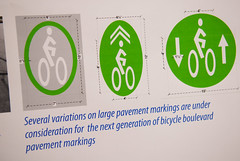
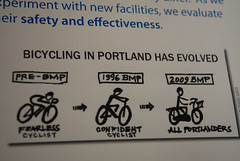
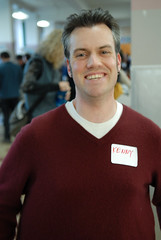
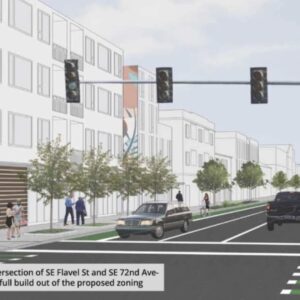

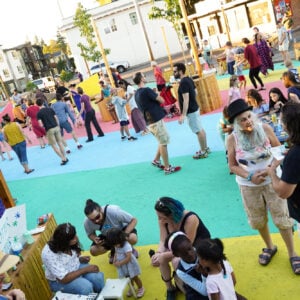
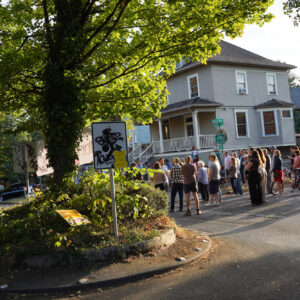
Thanks for reading.
BikePortland has served this community with independent community journalism since 2005. We rely on subscriptions from readers like you to survive. Your financial support is vital in keeping this valuable resource alive and well.
Please subscribe today to strengthen and expand our work.
Great report. I really like the evolution of Portland cycling you photographed. I share the vision that we’ll soon no longer have to identify ourselves as cyclists and can just be Portlanders.
It’s almost so at PSU.
Before all the nit-picking comments begin, I just want to say that this is a great plan and a wonderful presentation. I strongly encourage everyone who can to attend the next open house, you won’t be disappointed!
Sorry I missed it – too many meetings going on on the same days. 🙁
I look forward to seeing the draft plan – awesome work, guys!
60 BILLION for a single mile of freeway?
might want to double check that number, I’d believe 60 Million, but not Billion.
“might want to double check that number, I’d believe 60 Million, but not Billion.”
where did you see that?
i am curious about the dual focus of streetcars and bikes. did they mesh well or were they considered just separate issues. i am interested to hear what they have to say about the proposals in the same corridors, such as MLK/Grand (lots of ROW), Vancouver/Williams (not as much, but shouldn’t impact the existing bike lanes), and Lombard (gets pretty narrow).
@aljee
When I first read the post, I swear, I saw “60,000,000,000” not “60,000,000” as it appears now.
Thanks, K’tesh, but we only had 7 zeros in there! Appreciate your troubleshooting. – Elly
Are the posters from the meeting available online in case someone can’t make any of the meetings?
Amazing work, I can’t wait to attend the SW edition.
I particularly like “Create conditions to make bicycling more attractive than driving for trips of three miles or less.” There are two ways we can do this, and I think we should do both: obviously we can make bicycling more convenient, safer, and efficient. But I think we also need to make driving *less* attractive, by increasing the total time required to reach your destination (and park) by car. We can reduce speed limits, move more vehicular traffic to controlled arterials, and eliminate excess parking. That’s one way to demonstrate that we are really serious about developing a much greater user share for bicycles.
I like the new mission statement.
Concise, to the point, easy to digest.
The old one had too many this, and this, and this, and this, and this, and this… hard to read, hard to digest what was supposed to be going on! 🙂
Very interesting report, thanks BP crew! 🙂
Jeff:
I agree with you, but what you get from business owners is pushback with the claim that if it’s harder for customers to drive to their stores, they’ll shop elsewhere. I wish we have a ream of statistical data that shows this not to be true, but I don’t know of it. Does anyone have any good links? Most shopping data might be too colored by the recent economic downturn to be of much use.
I can supply theories why this might not be true, however. My favorite is that places with better bike and pedestrian facilities are, by their nature, better, more enjoyable places to be, and even car owners desire to be in those places to do their shopping. For every person turned away from a great neighborhood because of the inconvenience of parking or lower speed limits, there are many people who just want to go there anyway, and the trick now is to convince them that they can get there faster by bicycle or other non-car method.
We do have to demonstrate to the business community that it’s better for everyone in the long run to be located in a neighborhood not dominated by the automobile.
Woah. Not my best side in the photo I suppose.
It was really nice talking to you at the event, John.
aljee, from what I was gathering there was a holistic approach to cycling and transit when it came to adding street cars. All forms of transportation coming together. The graphs, many of the street examples, and maps expressed this type of planning.
The street car line looked super awesome. Covered so many locations…however, there was debate on whether to have it stop on Woodstock, and instead just approach passed 82nd somewhere near Foster.
There was this tentative “maybe” line on Woodstock…yet it went to Foster and Lents from what I was reading. Odd.
I say have the line come through our area and down to Sellwood, continuing to wrap around other districts of Portland.
On so many levels it just makes sense to reach my hood. We have college students, residents, young families, elderly, and lots of 1st time home buyers that would benefit from such service.
There is threat of 2 major bus lines disappearing (10 and 19) on the weekends (luckily I bike to downtown, etc).
I am seeing more density housing, as well live/work starting on the main street with businesses below.
Just wish for less subpar bars and replacing the barber shops with more funky local businesses. Good things are happening, just little by little.
I like that the change is taking place without the massive gentrification of some other districts.
Regardless, it is a charming community that is getting cooler every year, with so many essentials (library, TJ’s, grocery in general, Delta for fun and good grub, good thai food, good sushi at Tani’s, and Laughing Planet, First Cup serves Stumptown, Yoga, OK bars, great playground and dog park, Toast, Arleta Library Cafe is yummy). The cycling is even ‘good’…but I would like to see it get better. More bike boulevards…and the cool Copenhagen style lanes on the main street.
The Street car would be such a great way to get more of the community out of their cars and hopefully bring some of the businesses priced out of Hawthorne on the main drag of Woodstock.
I also believe “if you build it they will come”. This train will attract businesses I would want to go to.
How can I get Red and Black or People’s to rent the old Auto parts building near 41st and Woodstock??
This would be a big step toward removing some of the box store feel many have expressed about Safeway and Bi Mart.
Woops. Besides being long-winded…sorry for miss spelling your name “Jon”…no H.
; – )
As a point of clarification, these are not open houses exclusively for the Bike Master Plan. They are open houses to provide updates on both the Bike Master Plan and the Streetcar System Plan.
I understand this site’s focus is bikes, but prospective attendees would benefit from knowing these open houses are about both modes. PBOT staff and others are prepared to answer your questions about how the two modes interact, etc.
Please join us.
DJKenny,
love your enthusiasm for Woodstock. It is definitely an area moving in the right direction. I’ve lived here since 2002. I love seeing 1st time buyers and young families.
If you want to attract more bike and pedestrians. How about 1) shutting down a few cross streets to traffic, e.g., 44th between woodstock and ramona, or 2) make better connections to Springwater trail from bike streets to North, or 3) paving Springwater trail, or 4) finish Springwater trail along tracks through Sellwood.
bikeR I agree on all 3.
I tend to always end up taking the streets and zooming down to work toward downtown and taking the inclines back. The ride is pretty nice through Ladd’s and up to 41st. Just enough hill to “keep me honest” and provide a better cardio return too.
I would love to see business districts close the streets off to auto traffic, with exception being commerce delivery access.
One example would be closing Hawthorne off from just beyond Safeway to right before Freddie’s and 39th.
Woodstock…from 41st-52nd.
Parking coordinated around or above businesses… but the majority of access via foot, transit (bus and train) and bicycle.
Not only attracting business and making these areas more enjoyable to spend the day…stats have shown this system would likely “bring in” more business.